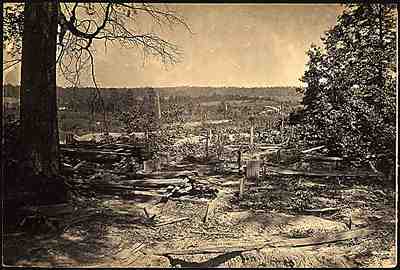
A good place to start your Civil War touring in Atlanta, this 33-acre complex includes the new Atlanta History Museum (30,000 square feet of exhibit space featuring the DuBose Civil War Collection), the Tullie Smith farm house (circa 1840), the Swan House (a 1928 mansion), and McElreath Hall which contains a research library and archives. In 1996, the museum will open a new, 9,200 square foot Civil War exhibit titled "Turning Point: The American Civil War." The Center, located close to the Peachtree Creek battlefield, has a wide variety of fine artifacts, not only from Georgia but from the rest of the Civil War field of operations as well. The History Center annually hosts a Civil War Encampment in July. Call the Center for details.

As the Union army fought its way to the outskirts of Atlanta in 1864, Confederate President Jefferson Davis decided it was time to make a change of command, relieving his old rival Joseph Johnston with Gen. John Bell Hood on July 18, 1864. (A monument of stacked cannonballs at 950 W. Marietta Road marks the Dexter Niles House site, where Johnston was fired.) Davis was frustrated with the reticent Johnston's retreats, and now the enemy was at the door of Atlanta. Hood, who had already lost a leg and use of an arm in the Civil War, was a fierce fighter and loved to attack. Sherman was pleased that Johnston was replaced, regarding the wily Johnston as superior to the 33-year-old Hood. The first battle of the Army of Tennessee under Hood occurred near Peachtree Creek on July 20, 1864. Hood went against George "Rock of Chickamauga" Thomas' corps with a complicated battle plan which was poorly executed due to unfriendly terrain. The result was a Confederate loss, with more than 2,500 Confederate casualties compared to Thomas's 1,750. Twenty-third president-to-be Benjamin Harrison, grandson of President William Henry Harrison, led his 400 men from Indiana in a counterattack at Peachtree Creek where the line almost gave way to Confederate assaults. Today you can view portions of the battlefield at the City of Atlanta's Tanyard Creek Park located near the heart of Buckhead. (National park officials, wanting to establish a Civil War park to commemorate the Atlanta Campaign, came down to a decision between Kennesaw Mountain and Peachtree Creek. Kennesaw won out.) Many plaques and Georgia Historical Markers in the area explain the battle. South of Piedmont Hospital on Peachtree Street is a WPA monument marking the spot where Confederate troops opened the assault.
From 1853-1883, Atlanta's city hall and courthouse were located on the state
capitol grounds. (During the Civil War, the state capitol was located in Milledgeville
and temporarily moved to Macon.) During Sherman's
occupation from Sept. 2 to Nov. 1864, the 2nd Mass. Regiment constituting the
provost guard of Sherman's
army camped on this site. From here came the order to Atlanta citizens to evacuate
the city on Sept. 7th as Sherman
prepared to burn the city and go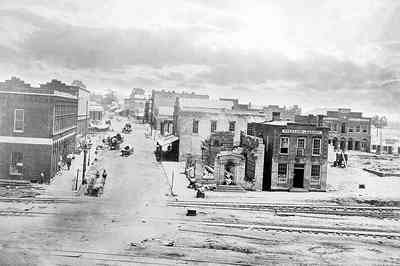 on his "March to the Sea." The present State Capitol was begun in
1884 and completed in 1889, for the cost of $999,881.57. It doubles as the official
museum of natural science and industry for Georgia. On the grounds is an excellent
statue of Georgia native Gen. John B. Gordon, who
organized the Raccoon Roughs in Georgia and led them to Virginia, where he rose
to command half of Gen. Robert E. Lee's army by the end of the war. Returning
home, the war hero served two terms as governor and three as senator. Another
statue shows Georgia's Civil War governor Joseph E. Brown
and his wife. Another interesting monument is "Expelled Because
of Color," honoring 33 black state legislators who were elected but
expelled from the legislature in Reconstruction Georgia in 1868. Four Civil
War plaques next to cannon on the grounds explain many of the events which occurred
in Atlanta. Inside the Capitol are displays, battleflags, paintings and statues
with Civil War significance. The statue of Benjamin Harvey
Hill, an effective supporter of Jefferson Davis, was originally erected
outdoors in 1886. At the dedication, Davis, making one of his last public appearances,
was introduced by newspaperman Henry Grady. Also attending were Confederate
gens. James Longstreet and John B. Gordon. Northwest of the State Capitol is
the Shrine of the Immaculate Conception church,
which is the oldest complete building standing in Atlanta, erected in 1869.
During the occupation of Atlanta, the church's pastor Thomas O'Reilly, convinced
General Henry Slocum to not burn five churches and City Hall. A few blocks north
of here in Underground Atlanta, is the Old Lamppost.
This 1855 gas lamppost was struck in the base by a shell during the
Battle of Atlanta on July 22, 1864. The shell ricocheted and exploded, injuring
Salomon Luckie, a freed slave and well-known barber, in the leg. He was carried
into a doctor's office to have the leg amputated and died a few hours later.
An Underground Atlanta historical plaque marks the location and tells the story
of Atlanta's Union Depot, destroyed by Sherman.
Heritage Row museum at Underground Atlanta (404-584-7879)
tells Atlanta's history in six interactive exhibit halls. A short walk from
the Capitol at 330 Capitol Avenue is the Department of Archives
and History (404-656-2393), which preserves the state's official records
and has a Civil War library.
on his "March to the Sea." The present State Capitol was begun in
1884 and completed in 1889, for the cost of $999,881.57. It doubles as the official
museum of natural science and industry for Georgia. On the grounds is an excellent
statue of Georgia native Gen. John B. Gordon, who
organized the Raccoon Roughs in Georgia and led them to Virginia, where he rose
to command half of Gen. Robert E. Lee's army by the end of the war. Returning
home, the war hero served two terms as governor and three as senator. Another
statue shows Georgia's Civil War governor Joseph E. Brown
and his wife. Another interesting monument is "Expelled Because
of Color," honoring 33 black state legislators who were elected but
expelled from the legislature in Reconstruction Georgia in 1868. Four Civil
War plaques next to cannon on the grounds explain many of the events which occurred
in Atlanta. Inside the Capitol are displays, battleflags, paintings and statues
with Civil War significance. The statue of Benjamin Harvey
Hill, an effective supporter of Jefferson Davis, was originally erected
outdoors in 1886. At the dedication, Davis, making one of his last public appearances,
was introduced by newspaperman Henry Grady. Also attending were Confederate
gens. James Longstreet and John B. Gordon. Northwest of the State Capitol is
the Shrine of the Immaculate Conception church,
which is the oldest complete building standing in Atlanta, erected in 1869.
During the occupation of Atlanta, the church's pastor Thomas O'Reilly, convinced
General Henry Slocum to not burn five churches and City Hall. A few blocks north
of here in Underground Atlanta, is the Old Lamppost.
This 1855 gas lamppost was struck in the base by a shell during the
Battle of Atlanta on July 22, 1864. The shell ricocheted and exploded, injuring
Salomon Luckie, a freed slave and well-known barber, in the leg. He was carried
into a doctor's office to have the leg amputated and died a few hours later.
An Underground Atlanta historical plaque marks the location and tells the story
of Atlanta's Union Depot, destroyed by Sherman.
Heritage Row museum at Underground Atlanta (404-584-7879)
tells Atlanta's history in six interactive exhibit halls. A short walk from
the Capitol at 330 Capitol Avenue is the Department of Archives
and History (404-656-2393), which preserves the state's official records
and has a Civil War library.
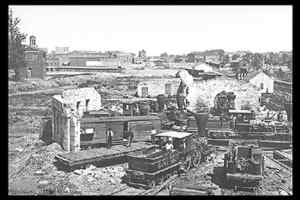
Rhodes Hall, built 1902-04, is the home of the Georgia Trust for Historic Preservation, an important organization committed to preserving Georgia's history. An interesting feature of Rhodes Hall — and one of the most unique Civil War oriented attractions in the nation — are nine complex stained glass windows made up of 1,250 pieces of German glass honoring the South during the Civil War. Called "The Rise and Fall of the Confederacy," the windows are set into three panels that range in height from 15 feet to nine feet as they follow a mahogany staircase. If you can identify all the individuals in the windows, you're an expert on the Civil War. The Georgia Trust is a good place to get answers on historic homes in Georgia.
The Battle of Atlanta was bloody, hotly contested, perhaps the most significant battle on Georgia soil, and possibly one that saved the Lincoln presidency and Union. It is best understood by first going to the Atlanta Cyclorama in Grant Park. The battlefield, located in east Atlanta, has been significantly changed by mass transit lines, highways and commercial development. The area is very congested, but there are some monuments and historical markers which, with some imagination, can help you visualize the battlefield. Historic Oakland Cemetery is considered by some to be the most beautiful cemetery in Georgia.
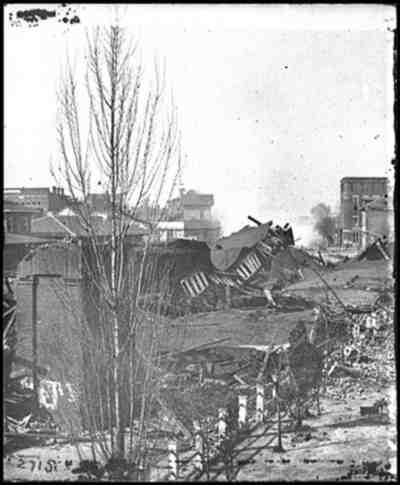
The Cyclorama not only tells history, but it is history. Considered the world's largest, the 9,000-pound painting measures 358 feet by 42 feet, which is longer than a football field. It was painted by German artists in the 1880s, who came to Atlanta and viewed the battlefield and interviewed battle veterans. Set in the round with three-dimensional figures added in the 1930s, it tells with emotional impact the story of the Battle of Atlanta. Commissioned by U.S. Maj. Gen. John "Black Jack" Logan, it was a travelling attraction when it came to Atlanta in 1892 and exhibitors ran out of money. Bought by philanthropist George Gress and given to the city in 1898, it was given its own building in 1921. Notice the dead figure of Clark Gable, added after Gone With The Wind premiered in Atlanta. The museum houses the famous Texas, the locomotive which captured the General in the "Great Locomotive Chase." Other interesting artifacts are on exhibit, and the museum has an excellent bookstore.
The Cyclorama is located in Grant Park, named for Col. Lemuel P. Grant, who helped design many of the 12 miles of fortifications circling and protecting Atlanta for 42 days during the Civil War, and donated the land making up Grant Park. All but a few fragments of this vast network of fortifications have disappeared: Fort Walker, an artillery bastion named for Georgian William H.T. Walker who died at the Battle of Atlanta, is located in the southeast corner of the park.
Oakland Cemetery has five Confederate generals,
a 65-foot tall memorial, 2,500 Confederate dead, the Lion of Atlanta, and to
top it off, the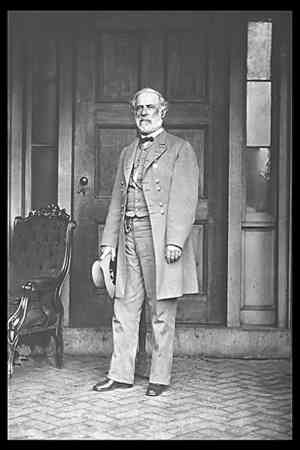 grave of Margaret Mitchell, author of Gone With
The Wind, the bestselling work of fiction of all time and for some the best
expression of what it means to be Southern. Established in 1850, Atlanta's oldest
cemetery is considered one of the finest Victorian Cemeteries
in America, with much elaborate statuary across its 88 acres. Confederate Generals
here are John B. Gordon, Alfred Iverson,
Jr., Clement A. Evans, William S. Walker,
and Lucius J. Gartrell. The vice president of
the Confederacy, A.H. Stephens was buried here until he was reinterred
at his home in Crawfordville, Georgia. Benjamin Harvey
Hill, another prominent Georgia politician in the Civil War is buried here.
Hanged and buried here until their reinterment in Chattanooga in 1866 were seven
of the Andrews Raiders of the "Great Locomotive
Chase." James Andrews was hanged at the corner of Juniper and Third and
buried near there, his remains lost until they were found and moved to Chattanooga
in 1887. Capt. William Fuller, Anthony
Murphy, and Jeff Cain, who chased Andrews,
are all buried in Oakland. Lincoln grieved over his brother-in-law's death,
Benjamin H. Helm, who was also interred here temporary
after suffering a mortal wound at Chickamauga.
Civil War burials occurred here before Sherman
got to Atlanta, with thousands of ill and wounded Confederate soldiers sent
to Atlanta for treatment at nearby hospitals. Today they rest in eight sections
of Oakland, one being unknown soldiers. One row in Section C has 20 Union
soldiers, who died in local hospitals. The Confederate
Obelisk, made from Stone Mountain granite, is 65-feet
high with a 20-foot base. It had its cornerstone placed on the day of Gen. Robert
E. Lee's funeral. At the dedication on Confederate Memorial Day, April 26, 1874,
it was the tallest structure in Atlanta. The Lion of Atlanta, designed to honor the unknown Confederate dead, was inspired
by the Lion of Lucerne, which was carved to honor the Swiss Guards who were
killed defending Marie Antoinette in 1792. This monument, weighing 30,000 pounds,
was carved from Georgia marble by T.M. Brady of Canton, Georgia. A plaque in
the cemetery near the sexton's house marks the site of the house where Confederate
Gen. John B. Hood watched the Battle of Atlanta, only a few blocks away. Union
occupiers vandalized the cemetery, opening crypts and stealing silver nameplates,
and burying Union dead in previously occupied coffins.
grave of Margaret Mitchell, author of Gone With
The Wind, the bestselling work of fiction of all time and for some the best
expression of what it means to be Southern. Established in 1850, Atlanta's oldest
cemetery is considered one of the finest Victorian Cemeteries
in America, with much elaborate statuary across its 88 acres. Confederate Generals
here are John B. Gordon, Alfred Iverson,
Jr., Clement A. Evans, William S. Walker,
and Lucius J. Gartrell. The vice president of
the Confederacy, A.H. Stephens was buried here until he was reinterred
at his home in Crawfordville, Georgia. Benjamin Harvey
Hill, another prominent Georgia politician in the Civil War is buried here.
Hanged and buried here until their reinterment in Chattanooga in 1866 were seven
of the Andrews Raiders of the "Great Locomotive
Chase." James Andrews was hanged at the corner of Juniper and Third and
buried near there, his remains lost until they were found and moved to Chattanooga
in 1887. Capt. William Fuller, Anthony
Murphy, and Jeff Cain, who chased Andrews,
are all buried in Oakland. Lincoln grieved over his brother-in-law's death,
Benjamin H. Helm, who was also interred here temporary
after suffering a mortal wound at Chickamauga.
Civil War burials occurred here before Sherman
got to Atlanta, with thousands of ill and wounded Confederate soldiers sent
to Atlanta for treatment at nearby hospitals. Today they rest in eight sections
of Oakland, one being unknown soldiers. One row in Section C has 20 Union
soldiers, who died in local hospitals. The Confederate
Obelisk, made from Stone Mountain granite, is 65-feet
high with a 20-foot base. It had its cornerstone placed on the day of Gen. Robert
E. Lee's funeral. At the dedication on Confederate Memorial Day, April 26, 1874,
it was the tallest structure in Atlanta. The Lion of Atlanta, designed to honor the unknown Confederate dead, was inspired
by the Lion of Lucerne, which was carved to honor the Swiss Guards who were
killed defending Marie Antoinette in 1792. This monument, weighing 30,000 pounds,
was carved from Georgia marble by T.M. Brady of Canton, Georgia. A plaque in
the cemetery near the sexton's house marks the site of the house where Confederate
Gen. John B. Hood watched the Battle of Atlanta, only a few blocks away. Union
occupiers vandalized the cemetery, opening crypts and stealing silver nameplates,
and burying Union dead in previously occupied coffins.
The Augustus Hurt House site, is located at the
Carter Presidential Center, located at 1 Copenhill Avenue, NE. This was Gen.
W.T. Sherman's headquarters
during the Battle
of Atlanta, where from less than half a mile away he saw the Confederate
breakthrough and ordered Gen. John Schofield's artillery to direct their fire
at the oncoming enemy. The unfinished brick Troup Hurt House,
featured prominently in the Cyclorama painting as the site of Confederate Manigault's
brigade's breakthrough, is marked by a historical marker
on DeGress Avenue. The stone Primitive 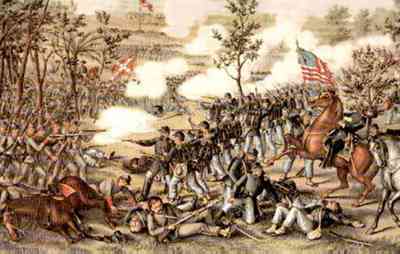 Baptist
Church sits on the site today. Leggett's or Bald Hill,
site of the Confederate attack on the Union flank, is located where Memorial
Drive, Moreland Ave., and Interstate 20 come together. Two Georgia Historical
Markers mark the spot at Trenton Street at Moreland Ave.
An upturned cannon marks the spot where Augusta-native Confederate Gen. William
H.T. Walker was shot by a Union sharpshooter, one of the first casualties
of the Battle of Atlanta. It is found at the intersection of Wilkinson and Glenwood
Avenue. Another cannon at McPherson and Monument Avenues marks the spot where
Union Gen. James B. McPherson was killed, not
long after Walker. The commander of the Union fighting forces that day was inspecting
his lines when he encountered some of Patrick Cleburne's troops, who asked him
to surrender. He tipped his hat, wheeled his horse, and raced away, only to
be shot dead through the back. An officer who was with him also dashed off and
hit a tree, breaking his watch and preserving the time of McPherson's death:
2:02. McPherson was the only Union army commander killed in the War, and according
to Sherman and Grant,
perhaps the most talented. Maj. Gen. John "Black Jack" Logan replaced
him at the Battle of Atlanta.
Baptist
Church sits on the site today. Leggett's or Bald Hill,
site of the Confederate attack on the Union flank, is located where Memorial
Drive, Moreland Ave., and Interstate 20 come together. Two Georgia Historical
Markers mark the spot at Trenton Street at Moreland Ave.
An upturned cannon marks the spot where Augusta-native Confederate Gen. William
H.T. Walker was shot by a Union sharpshooter, one of the first casualties
of the Battle of Atlanta. It is found at the intersection of Wilkinson and Glenwood
Avenue. Another cannon at McPherson and Monument Avenues marks the spot where
Union Gen. James B. McPherson was killed, not
long after Walker. The commander of the Union fighting forces that day was inspecting
his lines when he encountered some of Patrick Cleburne's troops, who asked him
to surrender. He tipped his hat, wheeled his horse, and raced away, only to
be shot dead through the back. An officer who was with him also dashed off and
hit a tree, breaking his watch and preserving the time of McPherson's death:
2:02. McPherson was the only Union army commander killed in the War, and according
to Sherman and Grant,
perhaps the most talented. Maj. Gen. John "Black Jack" Logan replaced
him at the Battle of Atlanta.
Read and add comments about this page